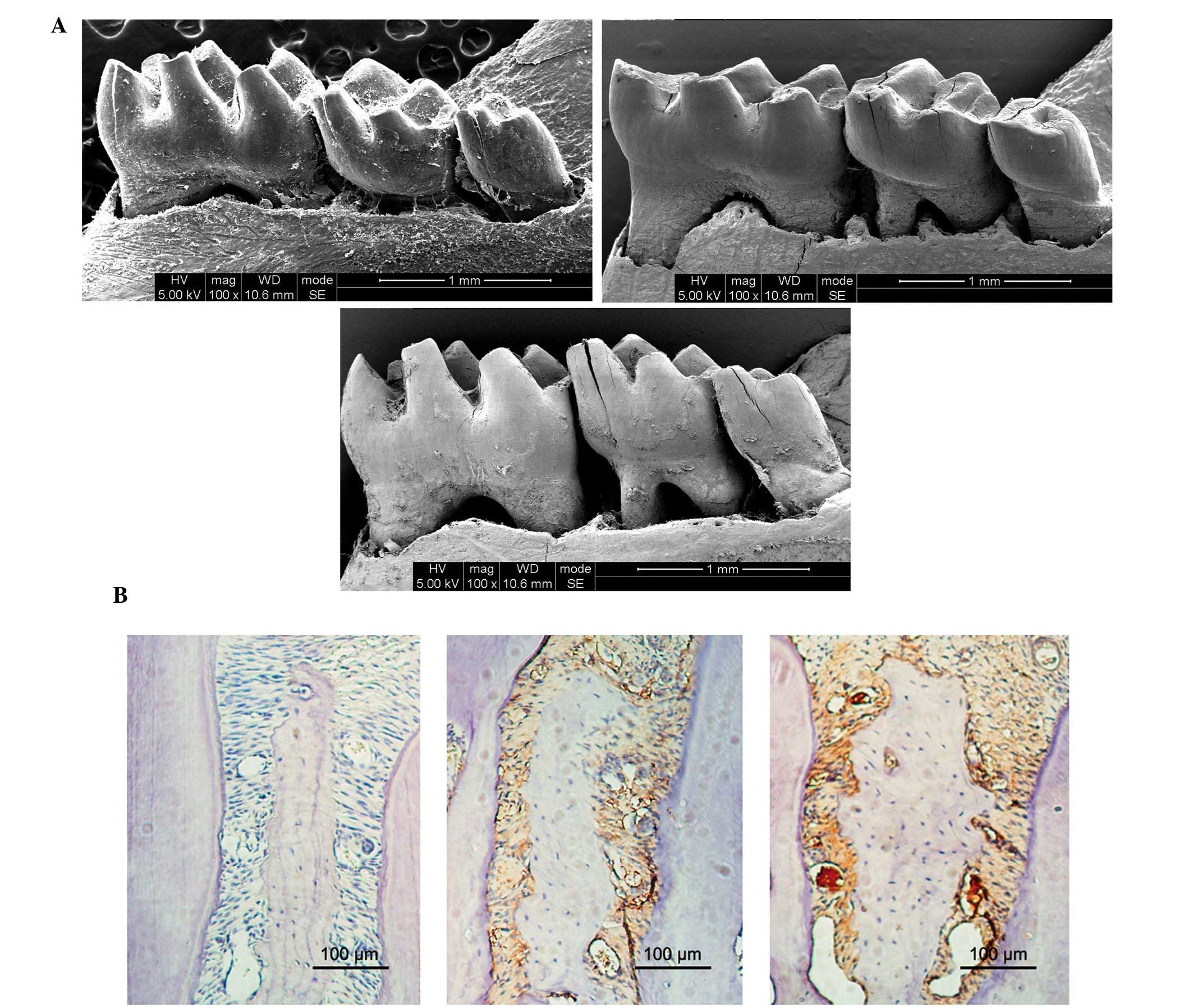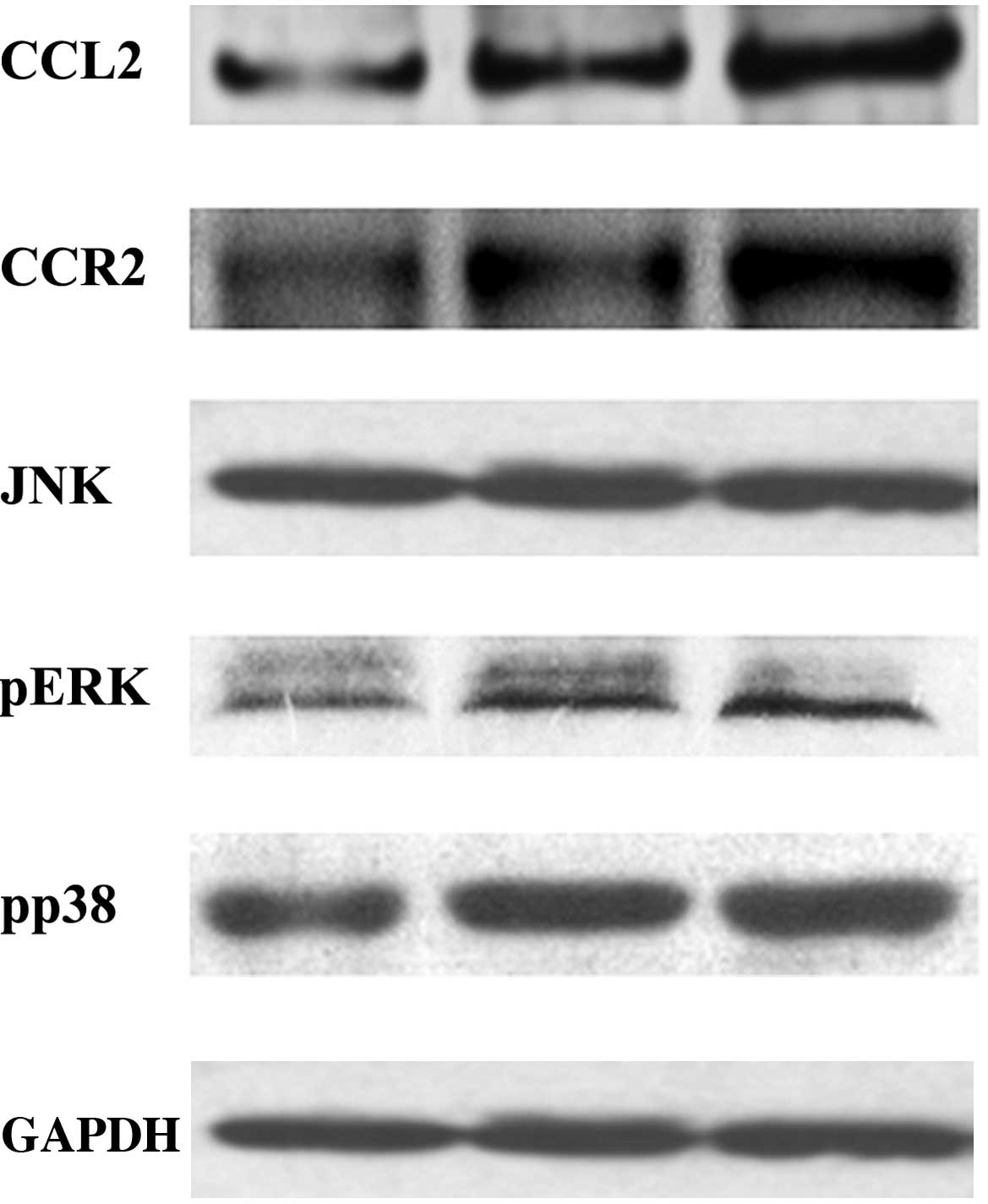|
1
|
Papadopoulos G, Weinberg EO, Massari P,
Gibson FC III, Wetzler LM, Morgan EF and Genco CA:
Macrophage-specific TLR2 signaling mediates pathogen-induced
TNF-dependent inflammatory oral bone loss. J Immunol.
190:1148–1157. 2013. View Article : Google Scholar : PubMed/NCBI
|
|
2
|
Veronica L, Saviuc CM and Chifiriuc MC:
Periodontitis and Periodontal Disease - innovative strategies for
reversing the chronic infectious and inflammatory condition by
natural products. Curr Pharm Des. Nov 12–2015.(Epub ahead of
print).
|
|
3
|
Graves D: Cytokines that promote
periodontal tissue destruction. J Periodontol. 79(Suppl):
1585–1591. 2008. View Article : Google Scholar : PubMed/NCBI
|
|
4
|
Herrera BS, Bastos AS, Coimbra LS,
Teixeira SA, Rossa C Jr, Van Dyke TE, Muscara MN and Spolidorio LC:
Peripheral blood mononuclear phagocytes from patients with chronic
periodontitis are primed for osteoclast formation. J Periodontol.
85:e72–81. 2014. View Article : Google Scholar : PubMed/NCBI
|
|
5
|
Hernández M, Gamonal J, Salo T,
Tervahartiala T, Hukkanen M, Tjäderhane L and Sorsa T: Reduced
expression of lipopolysaccharide-induced CXC chemokine in
Porphyromonas gingivalis-induced experimental periodontitis
in matrix metalloproteinase-8 null mice. J Periodontal Res.
46:58–66. 2011. View Article : Google Scholar : PubMed/NCBI
|
|
6
|
Sakallioğlu EE, Ayas B, Lütfioğlu M, Keleş
GC, Açikgöz G and Firatli E: Gingival levels of monocyte
chemoattractant protein-1 (MCP-1) in diabetes mellitus and
periodontitis: An experimental study in rats. Clin Oral Investig.
12:83–89. 2008. View Article : Google Scholar : PubMed/NCBI
|
|
7
|
Rauner M, Stein N, Winzer M, Goettsch C,
Zwerina J, Schett G, Distler JH, Albers J, Schulze J, Schinke T, et
al: WNT5A is induced by inflammatory mediators in bone marrow
stromal cells and regulates cytokine and chemokine production. J
Bone Miner Res. 27:575–585. 2012. View Article : Google Scholar : PubMed/NCBI
|
|
8
|
Shin Y, Han S, Jeon JS, Yamamoto K,
Zervantonakis IK, Sudo R, Kamm RD and Chung S: Microfluidic assay
for simultaneous culture of multiple cell types on surfaces or
within hydrogels. Nat Protoc. 7:1247–1259. 2012. View Article : Google Scholar : PubMed/NCBI
|
|
9
|
Wu J, Chen Q, Liu W, Zhang Y and Lin JM:
Cytotoxicity of quantum dots assay on a microfluidic 3D-culture
device based on modeling diffusion process between blood vessels
and tissues. Lab Chip. 12:3474–3480. 2012. View Article : Google Scholar : PubMed/NCBI
|
|
10
|
Gao D, Liu H, Lin JM, Wang Y and Jiang Y:
Characterization of drug permeability in Caco-2 monolayers by mass
spectrometry on a membrane-based microfluidic device. Lab Chip.
13:978–985. 2013. View Article : Google Scholar : PubMed/NCBI
|
|
11
|
Huh D, Matthews BD, Mammoto A,
Montoya-Zavala M, Hsin HY and Ingber DE: Reconstituting organ-level
lung functions on a chip. Science. 328:1662–1668. 2010. View Article : Google Scholar : PubMed/NCBI
|
|
12
|
Achyuta AK, Conway AJ, Crouse RB,
Bannister EC, Lee RN, Katnik CP, Behensky AA, Cuevas J and Sundaram
SS: A modular approach to create a neurovascular unit-on-a-chip.
Lab Chip. 13:542–553. 2013. View Article : Google Scholar : PubMed/NCBI
|
|
13
|
Graves DT and Kayal RA: Diabetic
complications and dysregulated innate immunity. Front Biosci.
13:1227–1239. 2008. View
Article : Google Scholar : PubMed/NCBI
|
|
14
|
Sulniute R, Lindh T, Wilczynska M, Li J
and Ny T: Plasmin is essential in preventing periodontitis in mice.
Am J Patho. 179:819–828. 2011. View Article : Google Scholar
|
|
15
|
Lamster IB, Lalla E, Borgnakke WS and
Taylor GW: The relationship between oral health and diabetes
mellitus. J Am Dent Assoc. 139(Suppl): 19S–24S. 2008. View Article : Google Scholar : PubMed/NCBI
|
|
16
|
Preshaw PM: Periodontal disease and
diabetes. J Dent. 37:S575–S577. 2009. View Article : Google Scholar : PubMed/NCBI
|
|
17
|
Ekuni D, Tomofuji T, Irie K, Kasuyama K,
Umakoshi M, Azuma T, Tamaki N, Sanbe T, Endo Y, Yamamoto T, et al:
Effects of periodontitis on aortic insulin resistance in an obese
rat model. Lab Invest. 90:348–359. 2010. View Article : Google Scholar : PubMed/NCBI
|
|
18
|
Gurzov EN and Eizirik DL: Bcl-2 proteins
in diabetes: Mitochondrial pathways of β-cell death and
dysfunction. Trends Cell Biol. 21:424–431. 2011. View Article : Google Scholar : PubMed/NCBI
|
|
19
|
Graves DT, Oskoui M, Volejnikova S, Naguib
G, Cai S, Desta T, Kakouras A and Jiang Y: Tumor necrosis factor
modulates fibroblast apoptosis, PMN recruitment, and osteoclast
formation in response to P. gingivalis infection. J Dent
Res. 80:1875–1879. 2001. View Article : Google Scholar : PubMed/NCBI
|
|
20
|
Gonzalez Y, Herrera MT, Soldevila G,
Garcia-Garcia L, Fabián G, Pérez-Armendariz EM, Bobadilla K,
Guzmán-Beltrán S, Sada E and Torres M: High glucose concentrations
induce TNF-α production through the down-regulation of CD33 in
primary human monocytes. BMC Immunol. 13:192012. View Article : Google Scholar : PubMed/NCBI
|
|
21
|
Amar S, Oyaisu K, Li L and Van Dyke T:
Moesin: A potential LPS receptor on human monocytes. J Endotoxin
Res. 7:281–286. 2001. View Article : Google Scholar : PubMed/NCBI
|
|
22
|
Lechleitner M, Koch T, Herold M, Dzien A
and Hoppichler F: Tumour necrosis factor-alpha plasma level in
patients with type 1 diabetes mellitus and its association with
glycaemic control and cardiovascular risk factors. J Intern Med.
248:67–76. 2000. View Article : Google Scholar : PubMed/NCBI
|
|
23
|
Górska R, Gregorek H, Kowalski J,
Laskus-Perendyk A, Syczewska M and Madaliński K: Relationship
between clinical parameters and cytokine profiles in inflamed
gingival tissue and serum samples from patients with chronic
periodontitis. J Clin Periodontol. 30:1046–1052. 2003. View Article : Google Scholar : PubMed/NCBI
|
|
24
|
Sassy-Prigent C, Heudes D, Mandet C,
Bélair MF, Michel O, Perdereau B, Bariéty J and Bruneval P: Early
glomerular macrophage recruitment in streptozotocin-induced
diabetic rats. Diabetes. 49:466–475. 2000. View Article : Google Scholar : PubMed/NCBI
|
|
25
|
Nomura S, Shouzu A, Omoto S, Nishikawa M
and Fukuhara S: Significance of chemokines and activated platelets
in patients with diabetes. Clin Exp Immunol. 121:437–443. 2000.
View Article : Google Scholar : PubMed/NCBI
|
|
26
|
Saeki K, Kanai T, Nakano M, Nakamura Y,
Miyata N, Sujino T, Yamagishi Y, Ebinuma H, Takaishi H, Ono Y, et
al: CCL2-induced migration and SOCS3-mediated activation of
macrophages are involved in cerulein-induced pancreatitis in mice.
Gastroenterology. 142:1010–1020.e9. 2012. View Article : Google Scholar : PubMed/NCBI
|

















